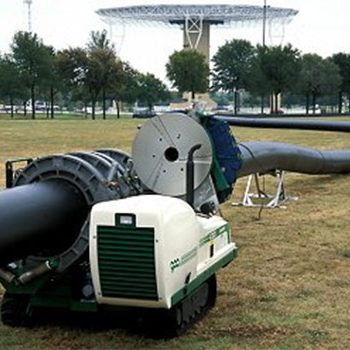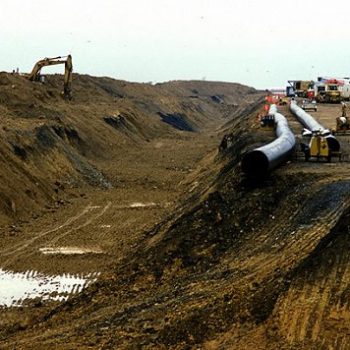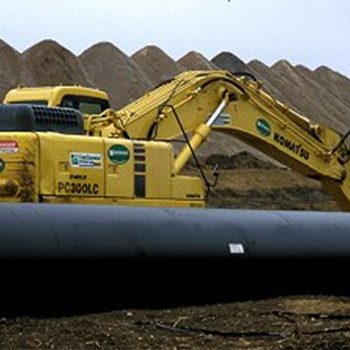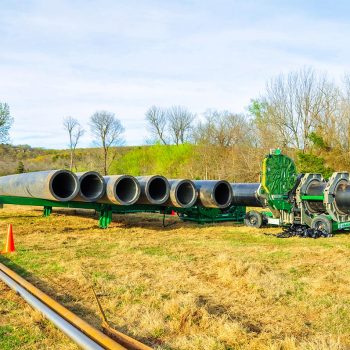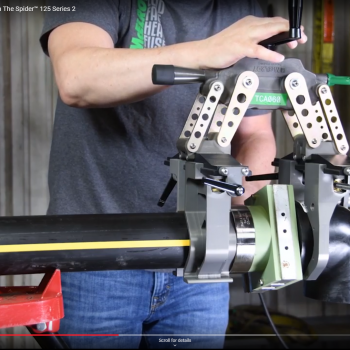Dallas Texas—Located between the cities of Dallas and Fort Worth, Texas, DFW International Airport is the world’s third busiest, serving 55 million passengers a year. Despite the slowdown of air travel after the terrorist attacks of September, 11 the airport is undergoing a five-year, $2.6 billion expansion that is due to be completed in the first quarter of 2005. The venture is so large that over 50 architectural and engineering firms are working on the project.
A $5 million portion of the project is a pipeline that will transport glycol runoff to a new treatment plant. Glycol is a compound used to make antifreeze and de-icing solution. The glycol is sprayed on the exterior of planes to prevent ice from forming on the plane. The runoff of the glycol is collected through catch basins underneath the de-icing locations. From there, gravity pipelines will carry the runoff to the treatment plant that will remove the glycol from the water and pump it back through a force main to the de-icing locations to be reused.
In 1992 an airplane crash at New York’s LaGuardia Airport was blamed on inadequate de-icing. Shortly following the incident the Federal Aviation Administration (FAA) imposed more stringent requirements on deicing to increase safety. The higher volume of glycol use has led to increased levels of the chemical in the waterways, which is toxic to fish, algae and bacteria. The EPA has classified the glycol material as a regulated industrial process wastewater. As a result, de-icing fluid wastewater has become both an economic and environmental liability for airports throughout the US and Canada.
The environmental safety factor is a major concern and for this reason engineers chose to use high-density polyethylene (HDPE) to transport the glycol runoff because HDPE is rated as a leak free piping system.
Polyethylene is so forgiving and easy to work with
HDPE is the only piping material in existence that has a leak free rating and was first used in the gas industry in the 1970’s. Today 90% of all gas lines installed are polyethylene. It has also found a home in mining operations that handle toxic fluids as well as wastewater, storm water, potable water, raw water transmissions, and numerous other applications such as transporting slurry mixtures and slip lining old pipe for rehabilitation purposes.
With 47 states experiencing water droughts this year, HDPE is also gaining rapid acceptance as a potable water conservation tool. It was first used in the water industry for horizontal bores under roadways and river crossings but now the same characteristics that made those projects possible, are appealing to pipeline contractors as a way to more easily construct the entire water system.
“Polyethylene is so forgiving and easy to work with,” said Dave Hiller of Maskell-Robbins (MR) speaking of the installation procedures involved with HDPE. MR is a distributor and fabricator of polyethylene pipe and fittings as well as the largest fusion machine distributor for McElroy fusion equipment. MR has seven locations that stretch from Houston Texas to Anchorage Alaska. MR provided the pipe and fusion equipment as well as the qualified fusion technicians for the DFW project. “When you combine the ease of installation to the leak free qualities, it’s a win-win combination,” said Hiller.
Azteca Construction, Inc. is the general engineering and building contractor for this project. As a Minority Business Enterprise and a Small Disadvantage Business, Azteca concentrates on Federal, State and local agencies construction contracts which compromise over 90% of their total revenues. “This is a pretty ambitious pipeline system,” said Jim Hammond, Project Manager for Azteca. “But by building the pipeline the airport will be able to eliminate all of the trucks that have been used to transport the glycol in the past.
“The gravity pipeline will consist of over 16,000 ft of 28″; 42″ and 48” polyethylene pipe manufactured by Rinker Polypipe and will gradually slope to a depth of 39 feet by the time it reaches the treatment plant. To safely dig a trench to that depth, the banks of the trench must slope on a one to one ratio. “Excavating the trench as well as backfilling has been quite a task,” said Hammond. “At the proper slope of the banks we ended up with a diameter of about 80 feet across the top of the trench.” Manholes will be placed at 600 ft intervals for future maintenance in case something becomes lodged in the pipe as well as providing the ability to test the fluid concentration levels. Five auger bores ranging from 120ft to 700 ft, will also be performed. 24″ HDPE will be encased in 42″ steel pipe for the road crossings.
“Polyethylene offers properties that make it the best choice of pipeline material for many applications,” said Hiller. “The pipe is impervious to most aggressive chemicals and another advantage of the pipe is the way it is joined together.” “Polyethylene is heat fused together creating a joint that is as strong as the pipe itself making a leak proof, fully restrained joint,” said Hiller. “With no leaks, the pipeline becomes a monolithic structure that is able to flex with the moving earth without leaking and thrust block restraints are not required for most applications, which is a major cost factor for other piping systems.”
It is so vital that the pipeline not leak, strict stipulations for fusion operators on this project require that the technician have at least five years experience as a certified fusion operator. McElroy fusion equipment was put into operation to fuse the pipe together. McElroy has an entire line of TracStar fusion machines that are mounted on a track system that makes them the only mobile fusion equipment in the world. They also have an on-board generator which gives them the added benefit of being completely self contained. The TracStar 900 is the largest of the TracStars and was used for this job because of its ability to fuse 12″ ID through 36″ OD pipe. “The TracStar 900 is quite a jewel and it saves a lot of money because it eliminates two pieces of equipment,” said Hiller. “There is no need for a generator or a piece of equipment to move it from one fusion location to the next because this machine already has those abilities incorporated into the machine.” The TracStar 900 also has a unique Coach control system that can record every joint for a quality control report. For now, the DFW expansion is on schedule and this project is just one of many that is ongoing. HDPE is being installed whenever there is a need for a leak proof system.
